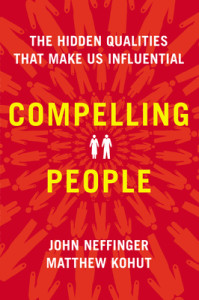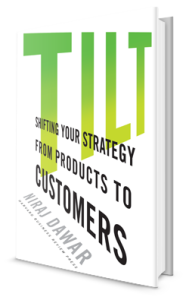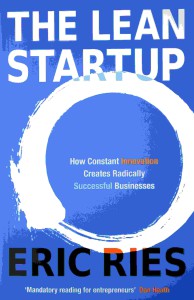I like to be on top of things by reviewing new books as they come out, so why am I reviewing a book that was published three years ago? Simply because the title misled me. I don’t run a startup and most of my readers don’t either, so I didn’t see a reason to read it.
But I had heard good things about The Lean Startup , so I decided to see what the fuss was about. The first point to make is that this book will profit anyone in business, from entrepreneurs all the way to bureaucrats in a vast organization. That’s because the definition of startup includes any new product, project or venture that requires acceptance by customers to succeed. (In my own case, I’m applying the principles to my writing projects and to a new market I’m focusing on—more of which in future posts.)
In my view, The Lean Startup is one of the most thoughtful and important books I’ve read in a long, long time. What’s not to like? So many of the topics I touch on in this blog and in my training are in here: clear thinking, customer focus, value, lean principles, and process orientation. The popular imagination tends to see entrepreneurship as a spark of genius, where someone turns a great idea or insight into a big business. But good ideas are often the least important part of the equation. Ries tells us that “…it’s the boring stuff that matters the most.”
The key idea is how to apply lean principles to startups. In a nutshell, lean is about eliminating waste, which is defined as anything that does not add value to the customer, using a very rigorous and data-driven approach. But in a startup, how do you define value when you often don’t even know who the end customer is? (And if you think you do, you’re probably way ahead of yourself—you’re operating on an untested assumption, to use Ries’ term)
The answer is that you measure progress toward the creation of value not through how the product is coming along, but by how much you’re learning about what customers will want and will pay for. After all, you can create a wonderful product full of all kinds of cutting edge features, and have it fall flat with customers. And it doesn’t do too much good to conduct focus groups to ask customers what they want because often they don’t know either.[1] Learning occurs through a cycle called the Build-Measure-Learn loop. You start with a hypothesis about what customers will value, then build a minimum viable product to test it, carefully collecting the right metrics that will lead to validated learning, then repeat as fast and as often as necessary.
Ries provides a very detailed road map through the Build-Measure-Learn loop using credible and compelling real world examples to illustrate such important concepts such as Minimum Viable Product, validated learning, innovation accounting, small batches, and Five Whys. It’s probably easier to grasp the concepts if you’ve had exposure to lean thinking, but if you haven’t, it pays to study the ideas closely—with a pen and paper at hand to write down all the good ideas that will spark in your mind.
My one quibble with the book is the definition of the word entrepreneur. Although I like the idea of defining a startup broadly, calling anyone who runs a startup, especially within a larger organization an entrepreneur is like blurring the distinction between the chicken and the pig when it comes to ham and eggs.
That quibble aside, I highly recommend this book.
[1] Ries doesn’t put it this way, but I see it as an ongoing dialogue between startup and customers, where you “say” something in the form of a product and see how the customer responds.
 Personal influence can be a slippery or vague concept to wrap your head around. Is it something you are either born with or without, or can it be dissected, analyzed and learned?
Personal influence can be a slippery or vague concept to wrap your head around. Is it something you are either born with or without, or can it be dissected, analyzed and learned?
Compelling People: The Hidden Qualities That Make Us Influential by John Neffinger and Matthew Kohut, comes down firmly on the second half of that critical question. The key ideas of the book are that:
a) personal influence is primarily a product of the reaction you engender in others, and
b) their perception is a product of the two dimensions of strength and warmth, and
c) using these two dimensions as a lens, you can make adjustments to your own approach to make yourself more influential.
Personal influence is primarily a product of the reaction you engender in others
As we’ve seen before, Aristotle said that ethos is the most important component of persuasion. Quite simply, people are willing to listen, learn and act depending on how they feel about the source. If they respect or fear the source, they will go along as long as the power remains. If they like the source, they might be more willing to be persuaded as long as it doesn’t go against their own interests.[1] Respect and liking together make for admiration and it can accomplish great things. So, how do you get there?
Understand the critical components of strength and warmth
Strength is the perception of your ability plus the will to get things done, and it’s critical to influence, because people won’t follow your lead on important matters if they see you as ignorant or weak. Yet strength by itself can only coerce or intimidate.
Warmth is empathy and concern for others. Warmth can get people to like you and want to do things for you, but warmth by itself can also get people to walk all over you.
The ideal leader or influencer is seen as both strong and warm. As that great influencer Al Capone said, “You can get further with a kind word and a gun than with a kind word alone.”
The problem is that strength and warmth are fundamentally in tension with each other. Dial up strength, and you risk being seen as cold or uncaring. Dial up warmth, and you might be seen as vulnerable.
Viewing persuasive influence through the dimensions of strength and warmth is like putting on polarized lenses, letting you see under the surface to the process below. In the week or so since I read the book, I’ve started seeing the relative amounts of either dimension in interpersonal contacts, both my own and others’. For another example, the controversy about relationship selling vs. challenger selling is fundamentally about the relative importance of each dimension.
That clearer view is what allows you to be smart about any adjustments that you need to make.
Dial up strength and warmth as needed
The bulk of the book is a practical “how-to”; once you have analyzed how you come across, you can figure out how to dial up each dimension. Although a lot of the recommendations are things you’ve probably seen before, they are explained comprehensively, clearly, and usefully. The main section of the book treats the nuts and bolts of influence, including nonverbal and verbal communication. The last section addresses how to use the ideas in the real world, such as in the workplace, in public speaking, even on-line.
You’ll have to read the book to get the individual recipes, but there are two critical messages in the how-to section. The first is that, although strength and warmth are largely determined by the hand you are dealt through genetics and upbringing, there is still a lot that you can change and control if you decide to. You can change behaviors and habits through knowledge and hard work, using the techniques described.
The second important theme is that there are two routes to those changes. One is outside-in, just doing things differently. For example, standing up straighter and taking up more space will not only make you look stronger, it can actually make you feel more powerful. It’s called embodied cognition, although most of us know it as “fake it ‘til you make it.” The inside-out route is more effective in the long term; if you change the way you feel inside, you will change your outward behaviors, e.g. the best way to show people you like them is to actually like them better. This sounds superficially obvious and difficult at the same time, but there are techniques described in the book that can help change your frame of mind.
If you’re still stuck on a gift idea for the influencer on your list (even if it’s yourself) I strongly and warmly recommend Compelling People.
[1] Machiavelli addressed this tension by asking whether it’s better for the prince to feared or loved. He concluded that it’s better to be feared, because people are quick to set aside their affection if they see the opportunity for gain or if they fear someone else more. But even Machiavelli acknowledged the importance of warmth by cautioning that even though a prince does not have to be loved, he should also not be hated.
 In the golden age of the industrial era, the key resource was the means of production, best symbolized by Ford, which emerged and thrived because of its mastery of mass production techniques that allowed it to capitalize on vast economies of scale. Companies gained competitive advantage by making and selling more and better stuff. In other words, they dominated the upstream activities.
In the golden age of the industrial era, the key resource was the means of production, best symbolized by Ford, which emerged and thrived because of its mastery of mass production techniques that allowed it to capitalize on vast economies of scale. Companies gained competitive advantage by making and selling more and better stuff. In other words, they dominated the upstream activities.
Today, as explained by Niraj Dawar in his book, Tilt: Shifting Your Strategy from Products to Customers, the center of gravity has shifted to downstream activities. Manufacturing and even new product development can easily be outsourced, so there is no longer any competitive advantage in controlling upstream activities. The key resource is now the customer’s mind. In this new world, companies compete on economies of scope: rather than asking “how can we sell more of what we make to customers?”, they are asking, “what else does the customer need?” A great example is Amazon, which doesn’t sell better stuff, it sells stuff better.
To succeed in the new tilted landscape, CEOs and marketers (and may I add, salespeople) need to be asking themselves new questions.
- Why do customers buy from us?
- Why do potential customers not buy from us?
- What else does the customer need?
- How else can we slash the customer’s costs and risks?
- Are we criterion takers, or criterion makers?
- My own addition: how else can we help them grow revenues or serve their customers better?
How does a company compete for downstream competitive advantage? Although the book considers both B2B and B2C companies, I’ll focus here on the former. In Part 2 of the book, Dawar explains how a company can use its “perch”, or higher and wider perspective of the market, to bring innovations and fresh insights to customers. Because they deal with large number and wide range of different customers, they can see the whole forest, and use their knowledge to relay and connect ideas, provide benchmarking information, and make predictions that add value.
The second section of the book dives deep into the scarce resource that we should all be competing for: the customer’s attention and cognitive effort. Dawar poses an interesting thought experiment. If Coca-Cola somehow lost all its physical assets, would they be able to raise funds to restart their business? The answer is clearly yes. But if somehow the entire world got partial amnesia and forgot about the Coca-Cola brand, would anyone invest billions of dollars in the business? Clearly not. The point is that a brand, or a customer’s perception of your company, is a critical asset because it lowers the customer’s costs and risks of making a decision to buy. They don’t have to expend much attention or think very deeply about their decision. That’s why downstream competitive advantage can be not just sustainable but accumulative. Through network effects, habit, and confirmation bias, the rich brands tend to get richer by gaining more and more mind share.
One interesting insight the book provides is that what is important is not being first to market, but first to mind. Anyone remember the Erwise browser or Chux disposable diapers? The incumbents have managed to define and dominate the customers’ purchase criteria, and the only ways for a challenger to overturn this dominance is to either provide an offering that is clearly superior in the important criteria, or change the criteria of purchase. You can either be a criterion taker, or a criterion maker.
There’s so much more I could write about this excellent book, but I’ll let you take it from here. Let me just say that if you aim to be an intrapreneurial sales professional, you need to read this book soon, and you need to sit down and seriously reflect on the six questions above.
P.S. If you don’t have time to read the whole book, read Dawar’s summary article in this month’s Harvard Business Review. If you don’t have time to read that, you have my sympathy.
International travel and communication are so convenient nowadays that it’s easy to forget that people in other cultures think and communicate differently than Americans do. If you make sales presentations in other countries and cultures, you need to adapt your presentations to fit those differences.
I’m working on a project for a multi-national client that involves understanding what works best for presentations in different cultures. While you can find a lot of material about general cultural differences[1], Presenting Across Cultures: How to Adapt Your Business and Sales Presentations in Key Markets Around the World, by Ruben Hernandez, is the only book I have found that specifically addresses the impact of these differences on presentations.
In general, the book is outstanding. Having taught and made sales presentations in over 20 different countries, I thought I knew a lot about how to adapt my own presentations. Some of what I read in Hernandez’s book validated adjustments I made, but I also learned a lot of new information that makes me wish I could go back and re-do some of them. In particular, I would like to reprise some of the questions I have answered in Asian countries. What I took as straightforward requests for information may have been my questioners’ way of expressing flat-out disagreement.
It also makes the point that some of the things that work best in US presentations, particularly to high level executives, may actually backfire in international settings. For example, I stress the importance of being clear, direct and concise in your presentation. That works in the US because we’re a low-context culture, and most of the meaning in our communications is contained in our words. In high-context cultures such as Asian countries, most of the meaning is contained between the lines, in their mannerisms, tone, and more importantly in what they don’t say. So, being too direct in those cultures will make you seem rude and make the audience uncomfortable.
As another example, it’s usually a good idea for American audiences to clarify and add impact to your points with examples and stories, but Germans interpret these expressions as talking down to them.
The best part of the book is the way Hernandez graphs 13 different dimensions along a line, and presents these visually for each of 16 countries/regions. If you’re planning a presentation overseas, you can turn to each of the countries listed and see differences at a glance, and then read the overall explanations plus a list of dos and don’ts for each.
My main quibble with the book is the small sample size that Hernandez used to calculate each dimension. He tells us that he interviewed 130 internationally-active business people. With 16 countries/regions listed, that works out to eight for each, so don’t get too wrapped up in precise differences between cultures. Still, that’s a bit like a blind man criticizing his guide for only having one eye. Until someone comes along with something that is more extensively researched and validated, this book sets the standard.
The book is arranged by culture, which works well. For my own purposes, I have found it useful to “pivot-table” the material, reorganizing it in a PowerPoint presentation by dimension, with the relevant values for each culture listed beneath.
For starters you will want to read the introductory material, get familiar with your own culture, and compare it to those of others you may present to. But the best use of Presenting across Cultures is as a reference guide that you should pack along with your passport if you have to go overseas to make a business presentation.
By the way, the book is just as valuable if you are a member of the audience. If you’re American, for example, you might judge a presenter harshly for spending too much time on background context, but they may just be doing exactly what seems right to them.
[1] Some good examples are: Figuring Foreigners Out, by Storti, Kiss, Bow or Shake Hands, by Morrison and Conaway and Cultures and Organizations: Software of the Mind, by Hofstede, Hofstede, and Minkov.




